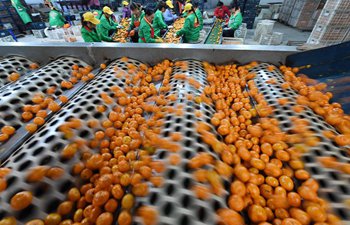CHICAGO, Dec. 5 (Xinhua) -- Researchers at the University of Michigan (UM) in the United States have obtained a structural snapshot of the proteins, and detailed them down to the atomic level.
This kind of detail may help in search for drugs to target the incorrectly folding proteins.
To understand the protein structure, the researchers use nanodiscs composed of layers of lipids surrounded by a belt. These lipids, bound by the belt, capture the proteins during their aggregation. The researchers then allow the protein to fold to a certain point within the nanodisc, as they think the folding proteins are most toxic to islet cells.
"We're able to stop the aggregation of the protein in this restricted membrane environment so we can monitor what it looks like before it becomes a mass of fibers," said lead researcher Ayyalusamy Ramamoorthy, UM professor of biophysics and chemistry.
At this point, the researchers use a technique called nuclear magnetic resonance spectroscopy (NMR) to make atomic-level images of the proteins. They also hope to use the technique to both develop and screen for drug compounds that can target the misfolding proteins that are implicated in aging-related diseases including Alzheimer's disease and prion disease.
"We are screening small molecule compounds to see if we can inhibit this aggregation process that produces amyloids," Ramamoorthy said. "This has been much wanted and much awaited information for the scientific understanding of the pathology of amyloid diseases, and for the development of compounds to overcome the problems."
Researchers are also using nanodiscs to study other proteins in the cell membrane and how different proteins interact with each other in the cell membrane.
The clumps of misfolded proteins, called plaques or amyloid fibers, are implicated in many diseases. Amyloids interfere with neuron function in the brains of people with Alzheimer's and Parkinson's, and they also kill islet cells, which produce insulin to regulate blood sugar levels in people with type 2 diabetes.

















